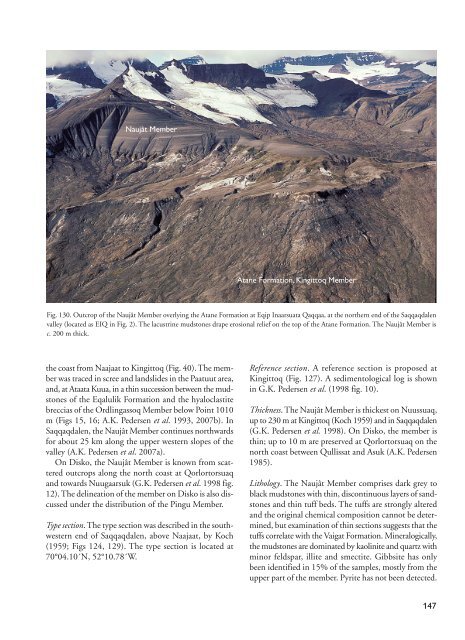Geological Survey of Denmark and Greenland Bulletin 19 ... - Geus
Geological Survey of Denmark and Greenland Bulletin 19 ... - Geus
Geological Survey of Denmark and Greenland Bulletin 19 ... - Geus
Create successful ePaper yourself
Turn your PDF publications into a flip-book with our unique Google optimized e-Paper software.
Naujât Member<br />
Atane Formation, Kingittoq Member<br />
Fig. 130. Outcrop <strong>of</strong> the Naujât Member overlying the Atane Formation at Eqip Inaarsuata Qaqqaa, at the northern end <strong>of</strong> the Saqqaqdalen<br />
valley (located as EIQ in Fig. 2). The lacustrine mudstones drape erosional relief on the top <strong>of</strong> the Atane Formation. The Naujât Member is<br />
c. 200 m thick.<br />
the coast from Naajaat to Kingittoq (Fig. 40). The member<br />
was traced in scree <strong>and</strong> l<strong>and</strong>slides in the Paatuut area,<br />
<strong>and</strong>, at Ataata Kuua, in a thin succession between the mudstones<br />
<strong>of</strong> the Eqalulik Formation <strong>and</strong> the hyaloclastite<br />
breccias <strong>of</strong> the Ordlingassoq Member below Point 1010<br />
m (Figs 15, 16; A.K. Pedersen et al. <strong>19</strong>93, 2007b). In<br />
Saqqaqdalen, the Naujât Member continues northwards<br />
for about 25 km along the upper western slopes <strong>of</strong> the<br />
valley (A.K. Pedersen et al. 2007a).<br />
On Disko, the Naujât Member is known from scattered<br />
outcrops along the north coast at Qorlortorsuaq<br />
<strong>and</strong> towards Nuugaarsuk (G.K. Pedersen et al. <strong>19</strong>98 fig.<br />
12). The delineation <strong>of</strong> the member on Disko is also discussed<br />
under the distribution <strong>of</strong> the Pingu Member.<br />
Type section. The type section was described in the southwestern<br />
end <strong>of</strong> Saqqaqdalen, above Naajaat, by Koch<br />
(<strong>19</strong>59; Figs 124, 129). The type section is located at<br />
70°04.10´N, 52°10.78´W.<br />
Reference section. A reference section is proposed at<br />
Kingittoq (Fig. 127). A sedimentological log is shown<br />
in G.K. Pedersen et al. (<strong>19</strong>98 fig. 10).<br />
Thickness. The Naujât Member is thickest on Nuussuaq,<br />
up to 230 m at Kingittoq (Koch <strong>19</strong>59) <strong>and</strong> in Saqqaqdalen<br />
(G.K. Pedersen et al. <strong>19</strong>98). On Disko, the member is<br />
thin; up to 10 m are preserved at Qorlortorsuaq on the<br />
north coast between Qullissat <strong>and</strong> Asuk (A.K. Pedersen<br />
<strong>19</strong>85).<br />
Lithology. The Naujât Member comprises dark grey to<br />
black mudstones with thin, discontinuous layers <strong>of</strong> s<strong>and</strong>stones<br />
<strong>and</strong> thin tuff beds. The tuffs are strongly altered<br />
<strong>and</strong> the original chemical composition cannot be determined,<br />
but examination <strong>of</strong> thin sections suggests that the<br />
tuffs correlate with the Vaigat Formation. Mineralogically,<br />
the mudstones are dominated by kaolinite <strong>and</strong> quartz with<br />
minor feldspar, illite <strong>and</strong> smectite. Gibbsite has only<br />
been identified in 15% <strong>of</strong> the samples, mostly from the<br />
upper part <strong>of</strong> the member. Pyrite has not been detected.<br />
147
















